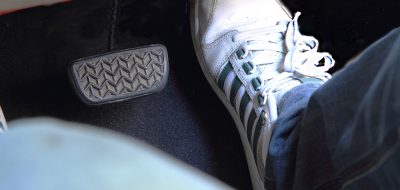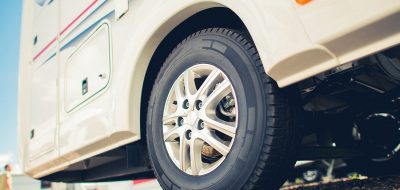There’s no question that fuel economy is at the top of every RVer’s list, so in the next few posts, I’m going to talk a little bit about ways to improve fuel economy. I’m not speaking of the typical suggestions, such as driving 55 mph or slower or monitoring tire pressure (although those do help), I’m talking about ways to reduce resistance overall. Reducing resistance improves efficiency, and that means better fuel economy.
Obviously, tire inflation pressure is important, but so is the type of tire that you use on your coach. A tire that is wider than necessary typically produces a better ride, but it can also increase rolling resistance. That’s why a lot of truckers are going to what is called a “super single” on the rear of their trailers; instead of duals, they run one very heavy-rated tire and wheel per side. Our shop hasn’t experimented with this, and the motorhome industry hasn’t introduced super singles yet, but it could come to that. A narrower, heavy-duty tire will ride rougher than its wide, cushy counterpart, so you’ll have to ask yourself if you’re willing to sacrifice a little bit of comfort for improved fuel economy. I should note here that a larger diameter tire won’t hurt fuel economy and may even help it, because a larger diameter tire turns fewer revolutions to cover the same distance and engine rpm is lowered as a result.
Alignment is also extremely important. This is a pretty broad subject, which is why we’re not going to try to cover it all in one post. Incorrect alignment can cause a lot of resistance, requiring more throttle input to maintain a given speed. “Toe in” is the most critical setting of them all. Simply put, “toe in” means the front of the tires are “pigeon toed”. Obviously, too much toe will also cause your tires to wear more quickly. Here’s a little graphic of what toe in/toe out looks like:
It’s a good idea to have the alignment checked even when the coach is new, because the factory runs them through the alignment procedure pretty fast. And, when the coach is loaded for travel, especially an independent front suspension (IFS) coach, the alignment changes as the load changes, except on self-leveling, air suspension coaches, where correct ride height is constantly maintained.
Straight axle coaches don’t change as much, but it’s still a good idea to check the alignment when loaded. One of the things we always recommend to our customers is that they ask the alignment shop, “When was the last time your equipment was calibrated?” We measure our alignment jobs in hundredths of an inch. This is important, because if the toe in is just 1/8-inch off spec, that is equal to 28 feet of side scrub per mile-a lot of resistance and tire wear.
Some toe in is necessary when the vehicle is in the static (parked) position, because as the vehicle travels down the road the front wheels will open up, and actually be pointing straight (zero toe in). This happens because most motorhomes have what is known as a “positive scrub radius” on the front axle. On the P32 Chevy/Workhorse chassis, we’ve found that the front alignment needs to be toed in a full ¼ inch at the static setting. The typical alignment shop would think that’s nuts, but we experimented with it, and that’s how much they require to stay at zero toe-in in the dynamic (moving) position. Static settings are important, but I’m more concerned with what the vehicle is doing as it drives down the road. We want the toe in to be as close to zero as possible when the vehicle is on the highway to assure the best possible fuel economy and tire life.
In the next post, we’ll talk about other alignment settings as well as rear axle alignment and trailer axle alignment. Happy travels!






Pingback: url
Robert A. Henderson
Hello Folks,
One of the big reasons the truckers use the big singles is to save weight. I understand it can be up to 400 lbs per side. This means more paylaod to a trucker.
However , Marge you are right about the flats. You just don’t pull over an put a spare tire on. They do not have a run flat tire available as far as I know. My Michein dealer said that trailer may not be quite as stable as it was before.
The big tires are not easy to find . So…. if you need one you may not be able to find it easy.
Safer and happier driving to you! Robert
marge
Question about replacing dual rear wheels with only one wide one…I thought part of the advantage of 2 had to do with security, if one went flat, the other was available to get you off the road. I have driven (slowly) for more than 5 miles to a station with only one of the duals having air. Don’t think I could do that with the single…do they have run-flat feature?
Brooker
Now on to the issue of the big tires on trucks, they have less roll resistance than most dual tires ( by compond type) and yes they do ride much better but they also do save you money two more ways,
1) the cost of one big tire is cheaper than 2 smaller tires.
2) the weight of 1 big tire and wheel combo is less than 2
So no matter how you look at it 1 big one is better that 2 little ones.
Brooker
Mike as for the milage on your 08 dodge all the new trucks have had there milage drop because of the emmisions now mandated on deisals, At this time i am unaware of any componies that offer anything to play with the settings, Just like the gas motors the aftermarket will come up with something but you have to be willing to wait.
Robert Henderson
Hey Mike,
There are many ways to improve fuel economy on your truck, many of which have been discussed here and in Part II. You are not the only one who has experienced poor fuel economy on these trucks, but there are some solutions. Many companies, such as BD Diesel Performance, offer tuning modules designed to improve fuel economy as well as improve towing performance. Here is a link to BD’s new Ultra X-Tuner, which is available for your truck: http://www.dieselperformance.com/index.php/product/index/153P. You can download a PDF of the manual for this product that describes, in detail what the product is and its various functions. I know another mod that Cummins owners use to improve fuel economy is an aftermarket torque converter. The stock torque converter has more stall speed than necessary, which reduces efficiency. BD, as well as other companies also offer torque converters for this application. A cold air intake and aftermarket exhaust may also improve fuel economy.
I have heard about hydrogen generators, but don’t have any experience with them myself. I can only say that when something sounds too good to be true, it usually is. Always exercise caution and do lots of research before trying any product with such incredible claims.
Mike Nordahl
I am the proud owner of a 2008 Mega-Cab with a Cunnins, my question to you is how can I improve my very poor fuel mileage? Tell me more about building a Hydrogen Generator. What other tricks are there to increase my milage. Thanks, Mike
Lawrence Golembiewski
Enjoyed the article and posted one of my own regarding biofuels. Please read at my website at http://www.gypsylarry.com and let me know what you think.
Thanks again.
Pingback: » Increase RV fuel mileage by lowering resistance RV Wheel Life: Julianne Crane writes about recreational vehicle lifestyle, people and destinations
Pingback: Minimize Resistance, Maximize Fuel Economy, Part II
Robert
Hello Tx,
Thank you for the comment. It is a good idea to find out what the manufactures recommends. However you need to remember that the manufacturer has a range for their specs. I recommend that you look and see if they publish the desired specs along with the range. You can be within specs and still have tire wear and or increased resistance. I recommend that you find out who your Workhorse Rep is and he should be willing to supply you with the factory specs. However the goal is to be as close to the desired or optimum specs.
Another thing that I may share is that we sometimes have to go outside of specs to achieve the results we are after. While this is seldom the case there are times with RV’s that we have had to go outside of the normal specs to achieve the desired results. Thank you.
Robert
Ps We are beginning to offer a series of after market parts from our SuperSteer Division for your coach. They are not on our website just yet.
Robert
Hello Darrel,
Excellent question! There is no way that you can measure it at all times while the coach is in motion, however we do know that if the vehicle has a positive scrub radius it will have a tendency to toe out while it is in motion.
If the vehicle has a negative scrub radius like most front wheel drive vehicles or all wheel drive vehicles it will have a tendency to toe in while in motion. So it is very important that you know the characterisctics of your suspension.before you align it.
Most of our RV’s that are motorhomes are built with a positive scrub radius. We used to have to carry more toe-in before radials tires came out. Now with radials it isn’t necessary due to way the belts are wound in a radial direction. This causes them to roll straighter. . So back to the point I made in the blog. We want the toe to be at zero while in motion. We can see how we are doing through the tire wear pattern. You can run your hand back and forth laterally across the face of the tire to feel for feathering. If you feel it from the outside in that is a sign of toe-out. If you feel it from the inside out it is toe in.
There is equipment made by Hunter Engineering that can measure toe in while you are rolling. It is not very common . I would caution you that you may get a false reading if you move the steering wheel when you drive across the plates.
I hope this helps.
Robert
——————————————————————————–
TXBrad
Robert: Great stuff: Sounds like you are saying one needs to get correct setting data # from Chassis Mfg. designer for a good alignment. I have a 2006 chassis /class C ( Chevy) & workhorse had a hand in design for GM ( Chevy). Workhorse is badged on my feders; but I have problems getting info from workhorse on design/engineering. Any POC for getting correct data. Concerns w/ local RV shops ?? Thanks
Darrel
I’m curious….how do you know what the toe in is when your driving down the road?